At 7 PM on Feb. 23, 1942, Goleta residents were settling in to listen to President Franklin Roosevelt’s Fireside Chat on the radio. The Japanese had just attacked Pearl Harbor two and a half months earlier and tensions were high for folks living on the coast.
Meanwhile, a 365 foot long Japanese I-17 sub came to a stop off of the Ellwood coast. The sub commander, Kozo Nishino, gave the order to prepare for action. A gun crew quickly took aim at a huge Richfield fuel tank just beyond the beach.

A very popular story says that Kozo Nishino had visited Ellwood many times before the war as the captain of an oil tanker, so he was familiar with this coastline, especially one particular cactus plant. But this has been proven to be a myth. Commander Nishino had actually been a Navy man since 1920 and never piloted an oil tanker. Read about the myth, Here.
The submarine had cruised to the Santa Barbara Channel with orders to bombard the Ellwood oil installations near Goleta. Ellwood boasted one of the largest oil fields in California and, unlike San Francisco or Los Angeles, did not have a major military presence, making it an attractive target for the Japanese Navy. Goleta did have a Coast Guard patrol boat stationed nearby, the Marines had a fleet of patrol bombers stationed at the Goleta airport, the army had troops spread along the coast as shore patrol, plus two howitzer cannons were at the ready, one at Coal Oil Point and the other at Ellwood. Mysteriously, all these defenses were relocated just days before this attack! Leaving only civilian volunteers at aircraft spotting stations.

Nishino ordered his men to fire at 7:15 pm, their first rounds landing close to one of the storage facilities. Most of the oil workers had gone home for the night, but the few that remained on duty heard the first rounds impact. They suspected an internal explosion, but a worker spotted the I-17 in the dark. An oiler named G. Brown later described the attacker as so big he thought it was a cruiser or destroyer, until he realized only one gun was firing. Nishino changed targets to a second storage tank. Brown and the others immediately called the police, but by this time Nishino’s men had fired several more rounds.
Wild shells landed on a nearby ranch. One round passed over Wheeler’s Inn, next to the classic filling station that still stands today, and owner Laurence Wheeler called the Santa Barbara Sheriff’s department. The deputy told Wheeler that warplanes would arrive shortly, but no planes came. A shell did strike the Ellwood Pier, damaging it slightly. A derrick and pump house were destroyed, while a catwalk was damaged.
Torpedo officer Nobukiyo Nambu climbed up the hatch to have a look and reported seeing, “a great deal of confusion”. After 20 minutes, Commander Nishino ordered his men to cease fire and the giant sub disappeared into the sea.
In August, 1943, this I-17 submarine was sunk by the Royal New Zealand Navy and US Navy planes near Australia.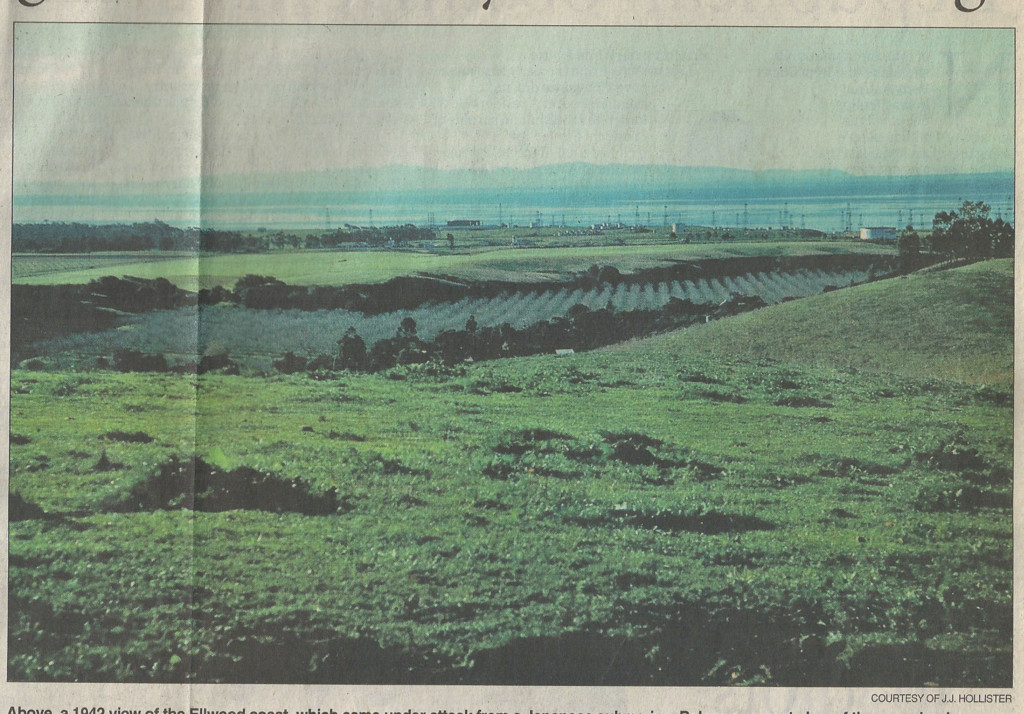
The sub fired armor piercing shells that were made for ship-to-ship combat, which is what they would usually be involved in. They had thick steel casings and very little explosives, so they were not very effective for causing onshore destruction. All 17 shells stored in the waterproof “ready locker” on the deck of the sub were fired.
A lone soldier keeps watch over Winchester Canyon while sitting beside a shell crater. One American soldier was injured while trying to deactivate an unexploded shell. He received a Purple Heart for his efforts.
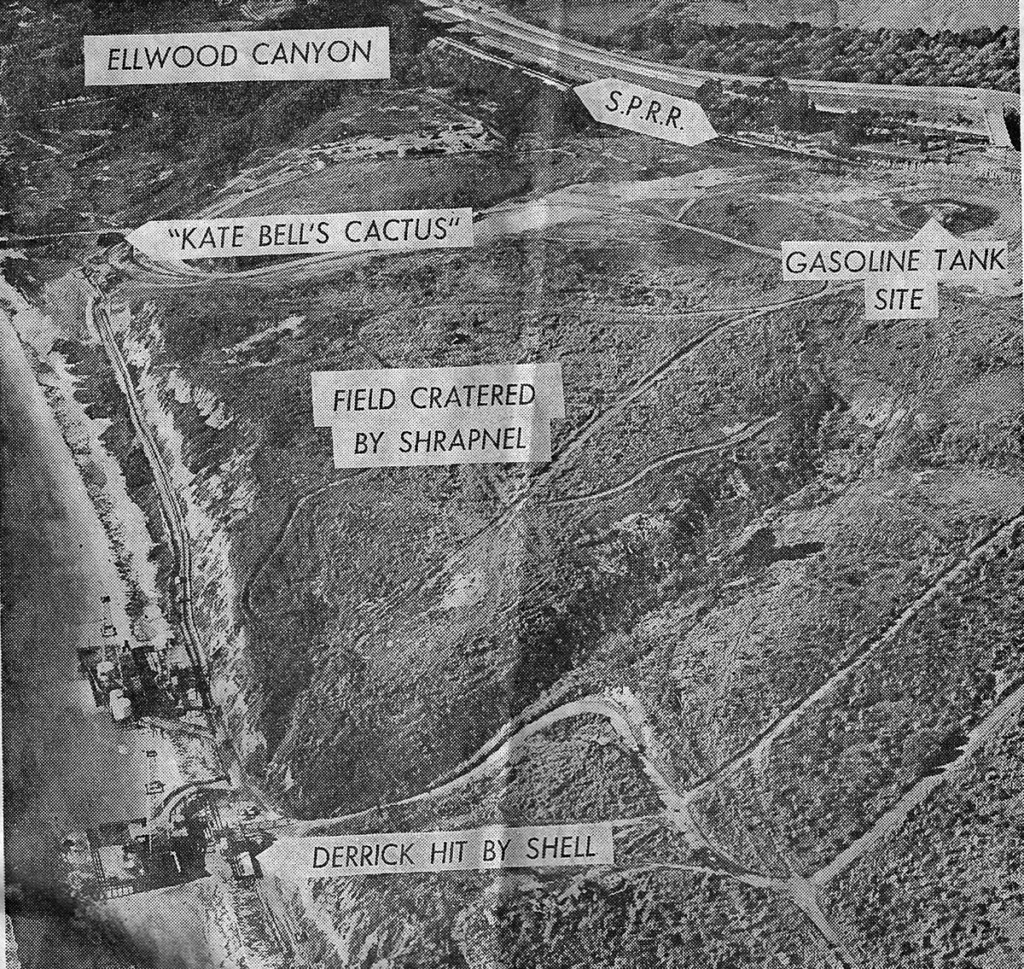
Hilda Wheeler, of the Wheeler Inn, described the scene:
“We saw the shells tearing up the ground as they landed between us and the ocean front. We couldn’t see the submarine because the sunset was very brilliant. We all thought at first it was target practice. And then we looked out back and saw the earth spurting up and we were scared to death. The third shot shook the building.” Laurence Wheeler added, “The others whined overhead and dropped into the canyon across the highway. Their marksmanship was rotten.”
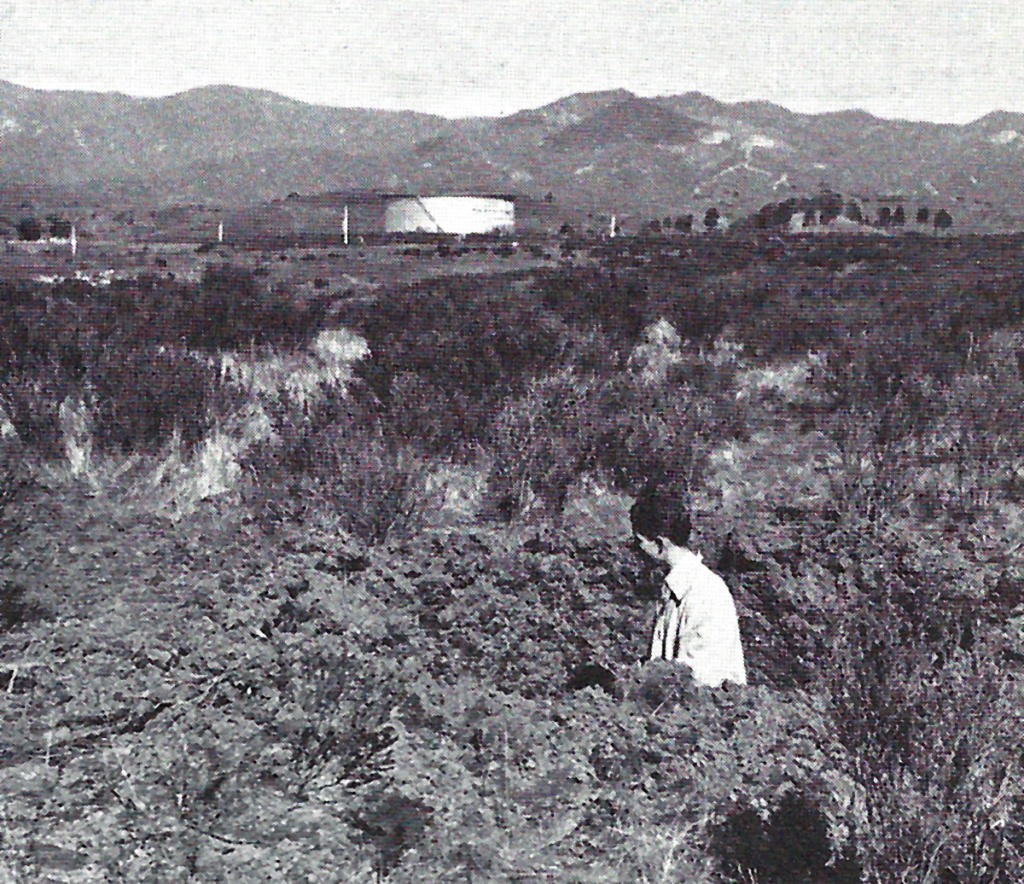 J.J. Hollister III was a 10-year-old boy listening to President Franklin D. Roosevelt’s “fireside chat” when he was startled by the thunder of a distant cannon. “In a moment or two we heard a whistling noise and a thump as a projectile hit near the house,” Hollister remembers. The family scrambled outside their home in Winchester Canyon and saw bright flashes near an oil field on the shore. Some shots were followed by “an eerie whistling and caterwauling,” Hollister said. “It was a sickening sound.”
J.J. Hollister III was a 10-year-old boy listening to President Franklin D. Roosevelt’s “fireside chat” when he was startled by the thunder of a distant cannon. “In a moment or two we heard a whistling noise and a thump as a projectile hit near the house,” Hollister remembers. The family scrambled outside their home in Winchester Canyon and saw bright flashes near an oil field on the shore. Some shots were followed by “an eerie whistling and caterwauling,” Hollister said. “It was a sickening sound.”
There was panic, mayhem and confusion. Phone lines were jammed with concerned citizens trying to find out what the explosions were about. The first phone call to get through to the News-Press was from a witness up at the Trout Club on San Marcos Pass. The night editor told the caller he was “loco” and hung up on him. Soon, the paper’s switchboard lit up with callers. Commuters on the highway were puzzled, but not alarmed by the “fireworks” they saw offshore as they passed through Goleta. A small crowd gathered at Wheeler’s Inn, exchanging stories and concerns for safety. By 8 PM, a blackout was in effect from Monterey to San Diego. All traffic was stopped on the 101 from Gaviota to Ventura to enforce a full blackout.

In the wake of the attack, rumors and conspiracy theories were flying around about the attack. Some folks swore that they saw lights in the hills signaling to the Japanese sub. Others insisted there were actually three submarines attacking and the Government was involved in a big coverup. Paranoia set in, just as the attack was meant to cause. In “Goleta, the Good Land”, Tompkins reports the theory that the submarine was not Japanese at all, but American. He writes that a sizable number of responsible eyewitnesses were convinced the whole attack was staged to wake people up and boost war bond sales. It certainly did both of those things.
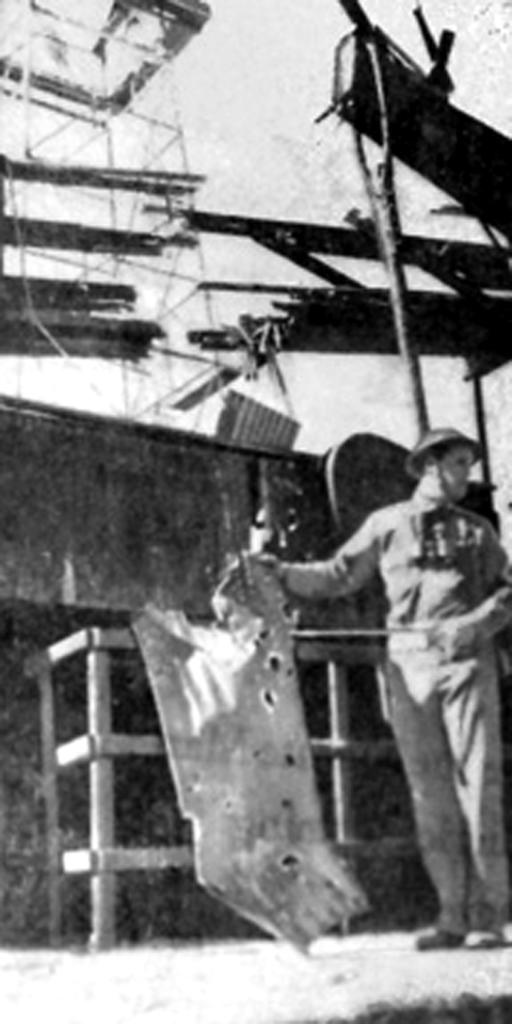 Total damage from the attack was assessed at $500. While the attack caused only minor actual damage, it had a significant impact on public fears.
Total damage from the attack was assessed at $500. While the attack caused only minor actual damage, it had a significant impact on public fears.
Security was tight, but a handful of reporters were allowed to inspect the damage firsthand and report on the incident. In the following days the hysteria continued, and hundreds of people fled the area.
The next few photos have never been seen before as they were provided to Goleta History by John Staneff. His family lived in Winchester Canyon at the time of the bombing and they took these photos soon after the event.
The shelling was the first attack on the mainland U.S. in World War II and it triggered widespread fears of invasion and subversion. Within months of the attack, tens of thousands of Japanese Americans would be sent to internment camps, where they would stay until early 1945.
Two days after the raid, a broadcast from Radio Tokyo announced, “Santa Barbara, California was devastated by enemy bombardment”.
Records of the Japanese Imperial Navy stated that they, “left Santa Barbara in flames”. Above is a Japanese postcard commemorating the I-17 shelling of the Ellwood refinery and storage facilities north of Santa Barbara. Image courtesy John Geoghegan.
Americans were indignant to see our country under attack. As the news spread across the country, the word went out to, “Avenge Ellwood! The “Avenge Ellwood” logo was created in early 1943 for a war bond drive led by the American Women’s Voluntary Services. The image was used in newspapers, on posters and by local companies that had donated to the cause. The money raised went directly to the purchase of a bomber plane and fighter plane that would boast the names “Flying Santa Barbaran” and “Ellwood Avenger.”
Unfortunately, the “Flying Santa Barbaran” bomber was never built, and the “Ellwood Avenger” attack plane never attacked anything, ending it’s short career when it banged into another plane on a Florida runway.
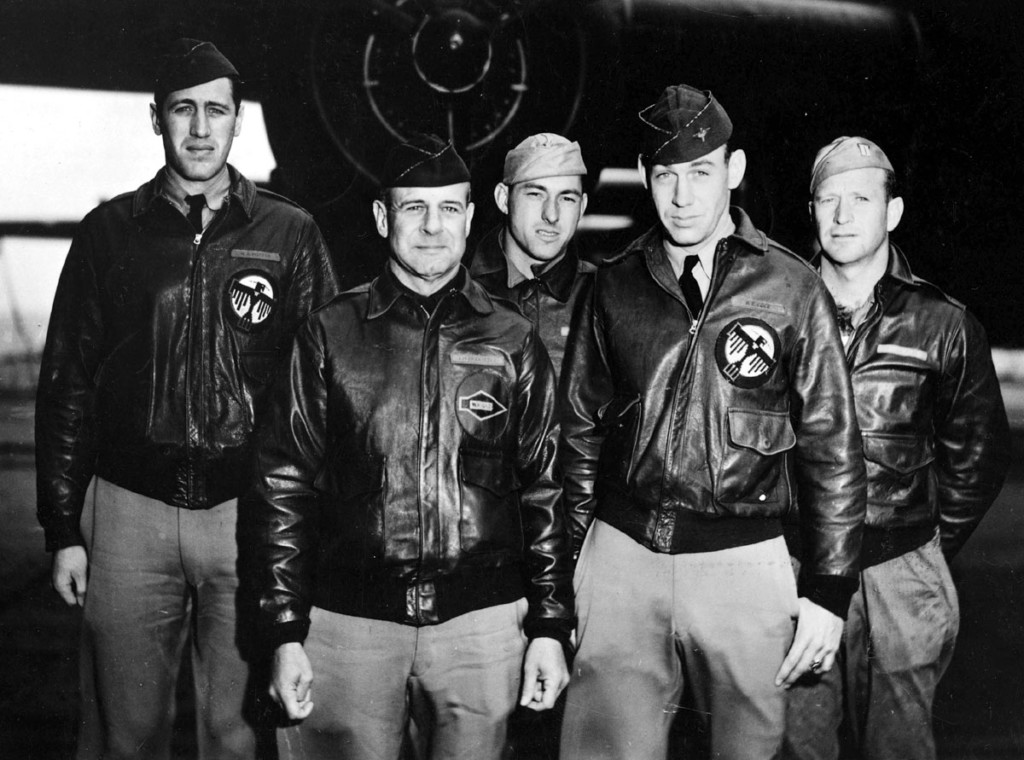 Less than two months after the attack in Goleta, James Doolittle and his Raiders would lead the first of many U.S. air raids on the Japanese homeland, showing that Japan was vulnerable to air attacks.
Less than two months after the attack in Goleta, James Doolittle and his Raiders would lead the first of many U.S. air raids on the Japanese homeland, showing that Japan was vulnerable to air attacks.
In 1953, Tex Blankenship purchased 20 acres of Ellwood land with the intention of building a restaurant on it. Tex also purchased timbers from the Goleta oil field pier that was bombed by the Japanese during WWII. He used them to start building the Timbers restaurant, but it was not opened until 1963 when the Velliotes family bought it. It has recently re-opened as the Timbers Roadhouse.
Today this sign can be found at Haskells Beach, commemorating the attack on Ellwood.

In 1967, this memorial was placed at Sandpiper Golf Course by the Native Sons of the Golden West.

The plaque reminds golfers of the infamous day at Ellwood. As time goes on, and generations pass, memorials like this will be all that is left to remind people of this important historic event.
See a cool video about this event.
Sources:
Justin Ruhge, Walker A. Tompkins, Ken Hough, John Staneff, Edhat, SB Independent, SY Valley News, Daily Nexus, Noozhawk, Goleta Valley Historical Society, S.B. News Press, L.A. Times, Ventura Star, Dennis Parker, Rob Evans, Wikipedia, worldwartwodaily.filminspector.com
Categories: Goleta History
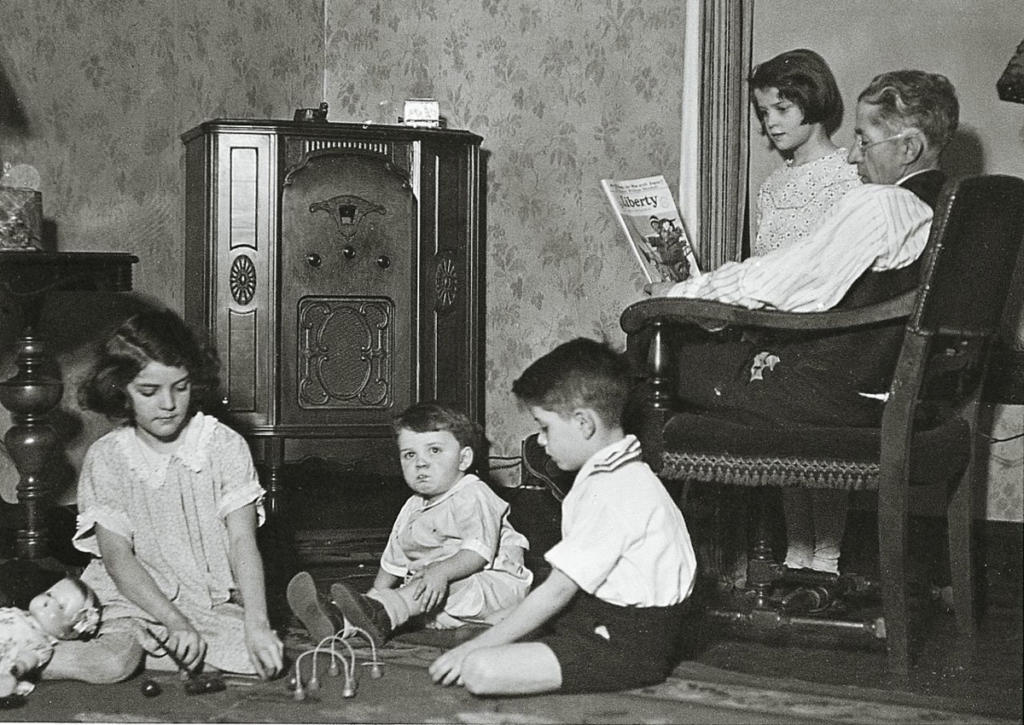
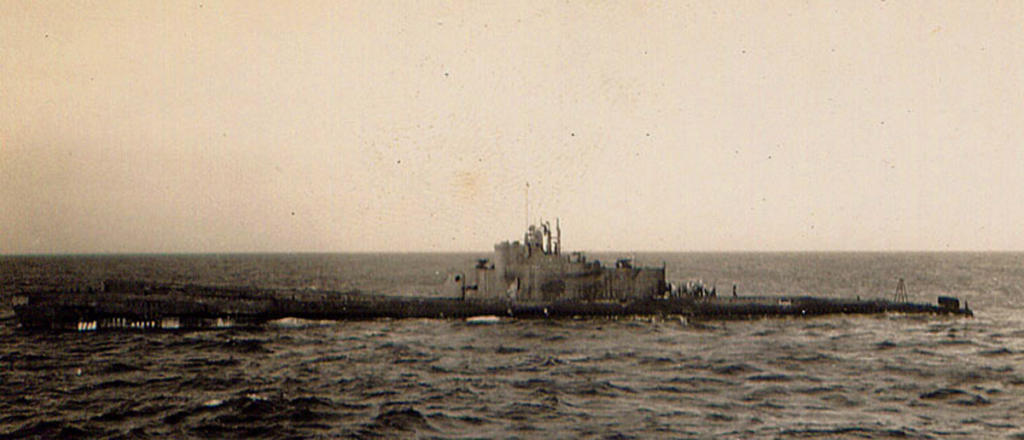
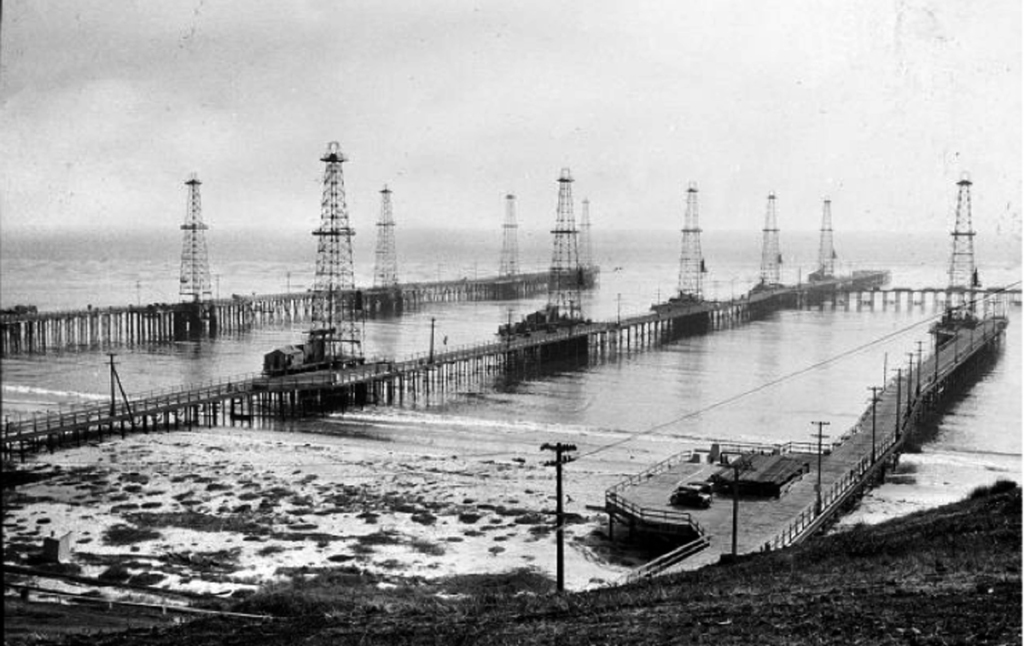
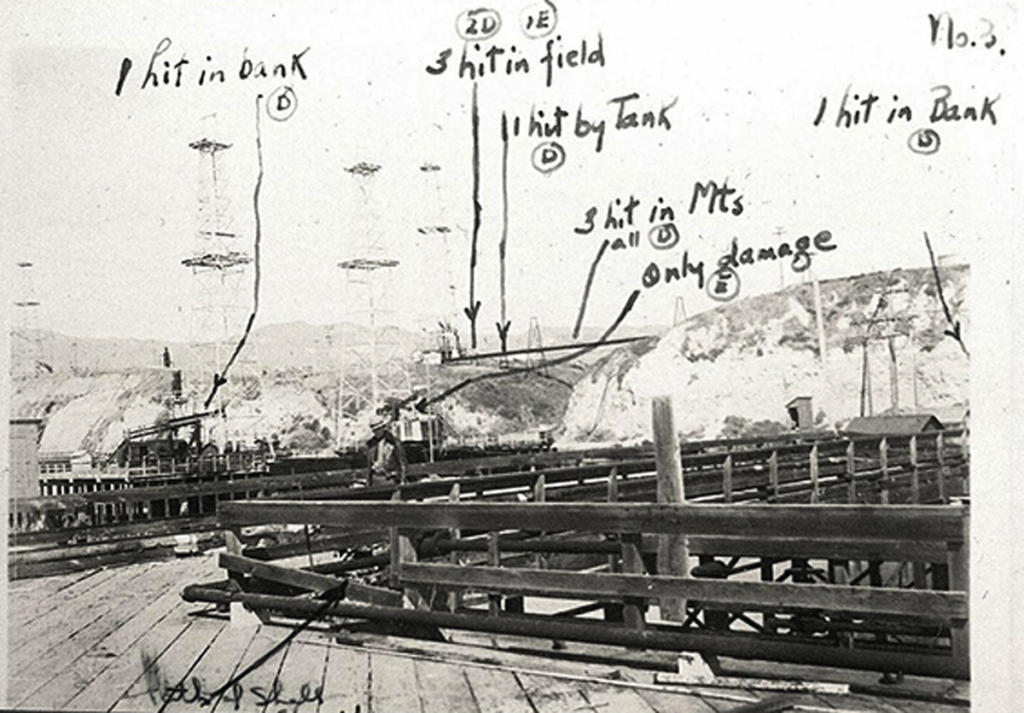
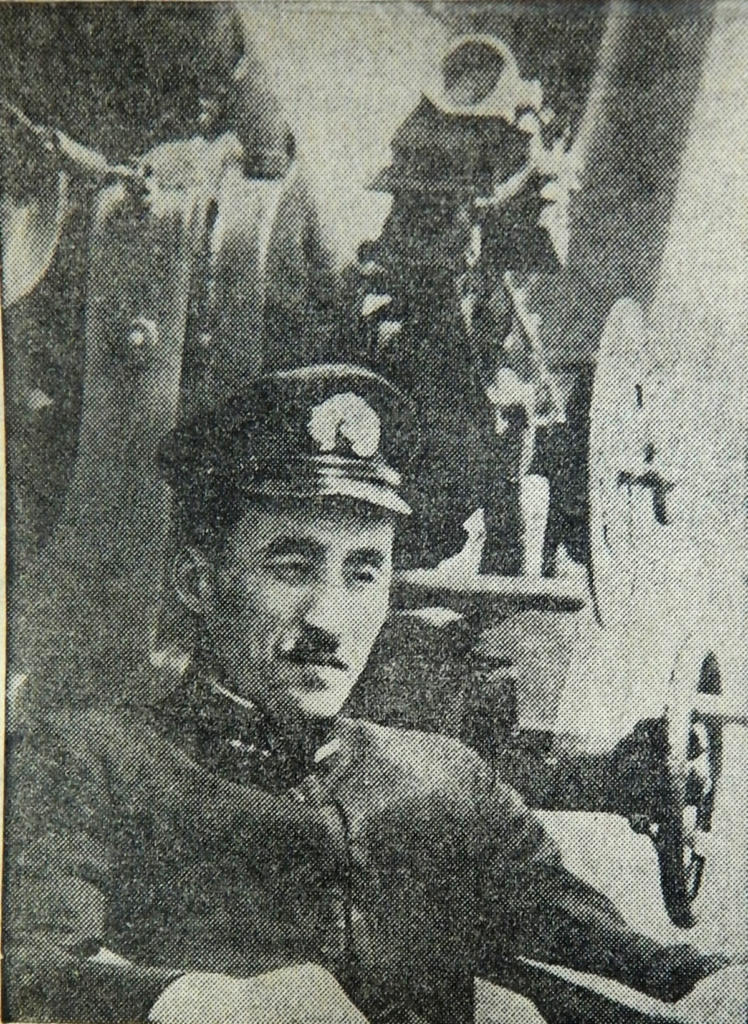
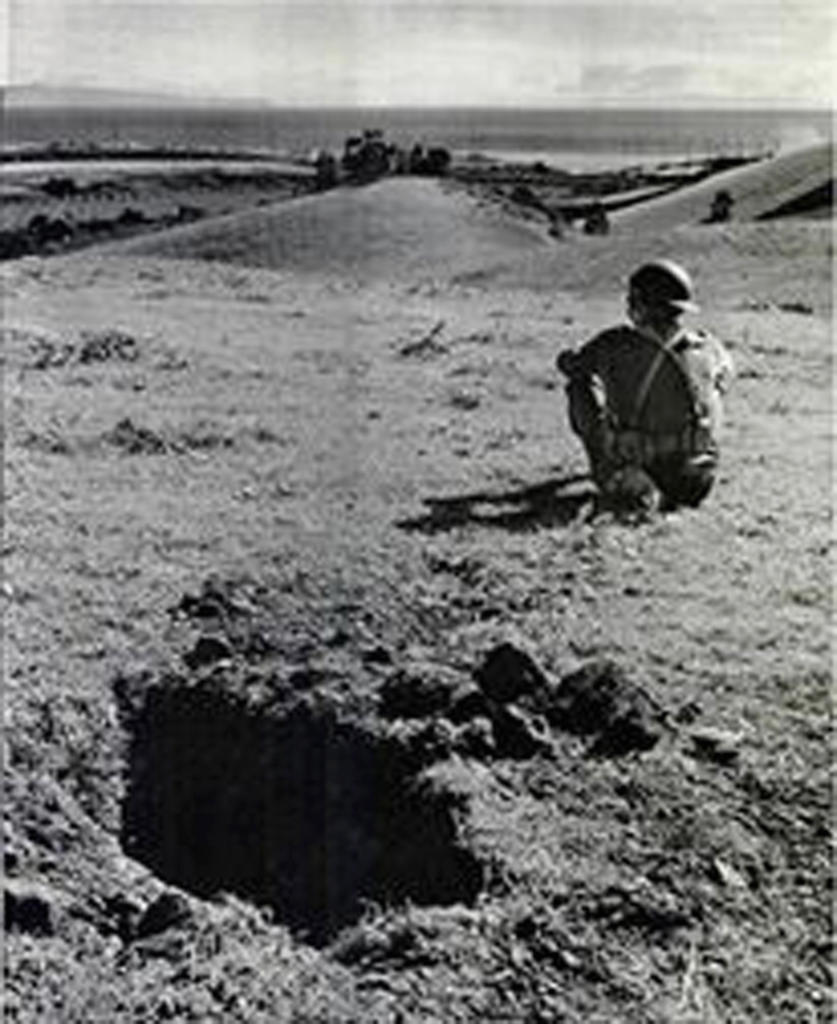
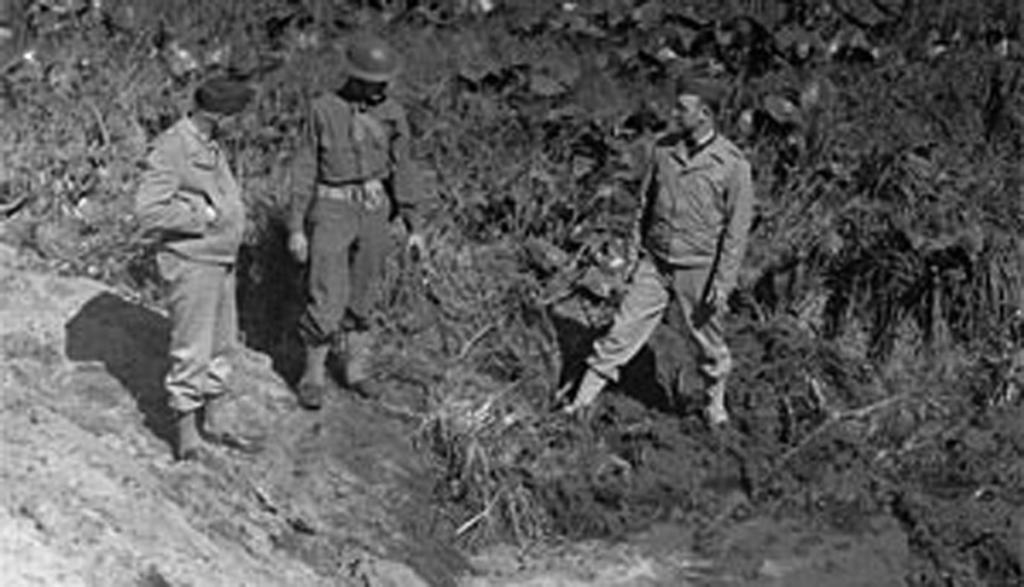
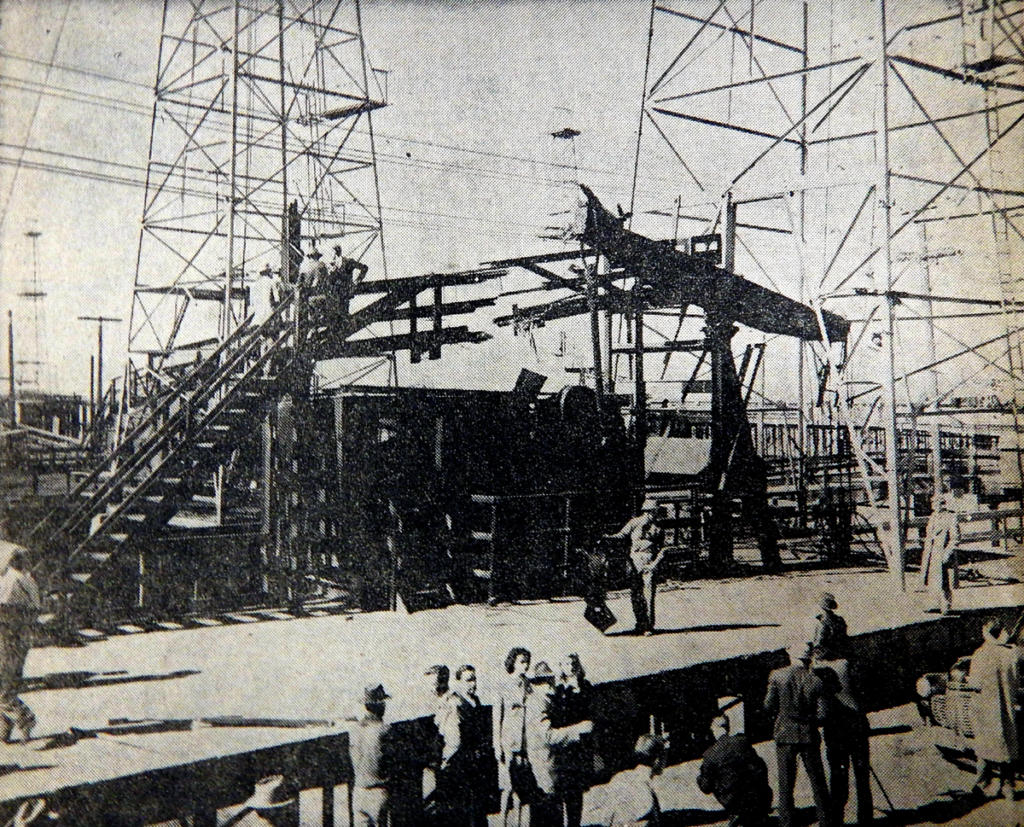
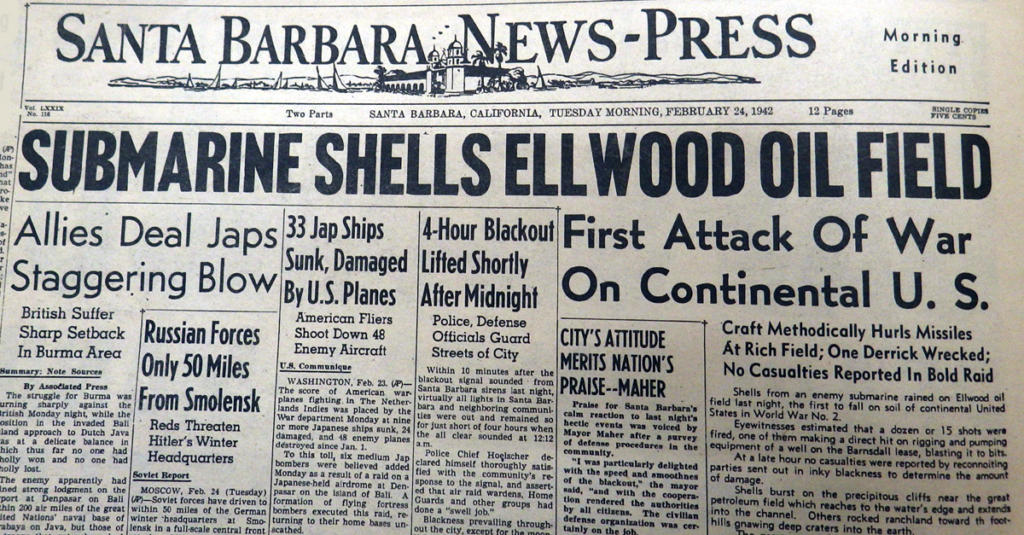
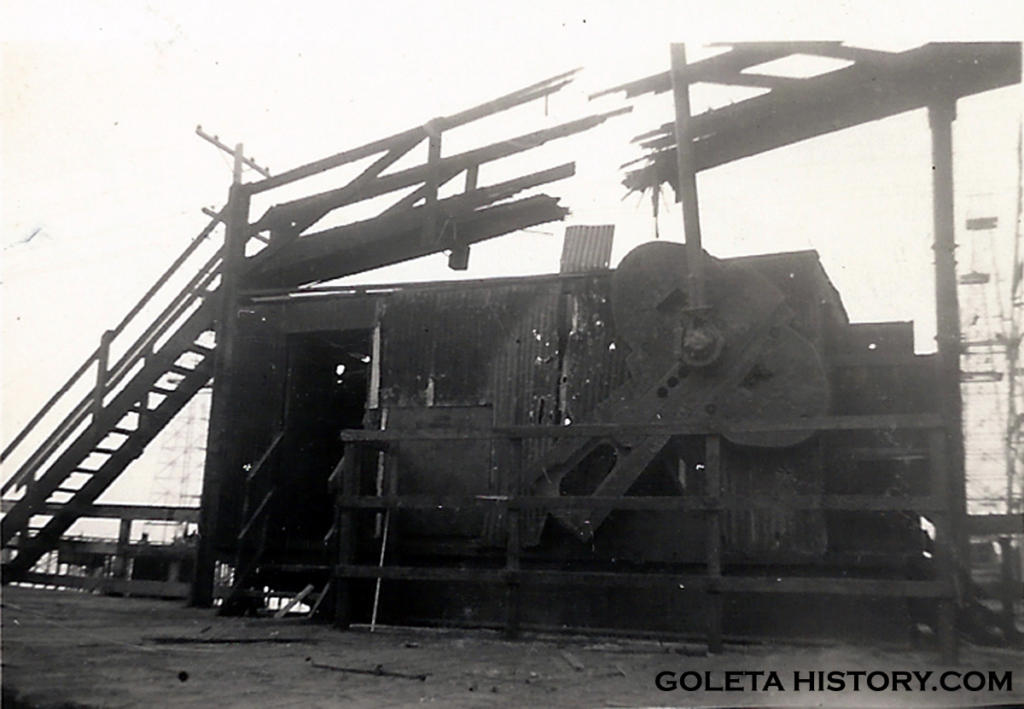
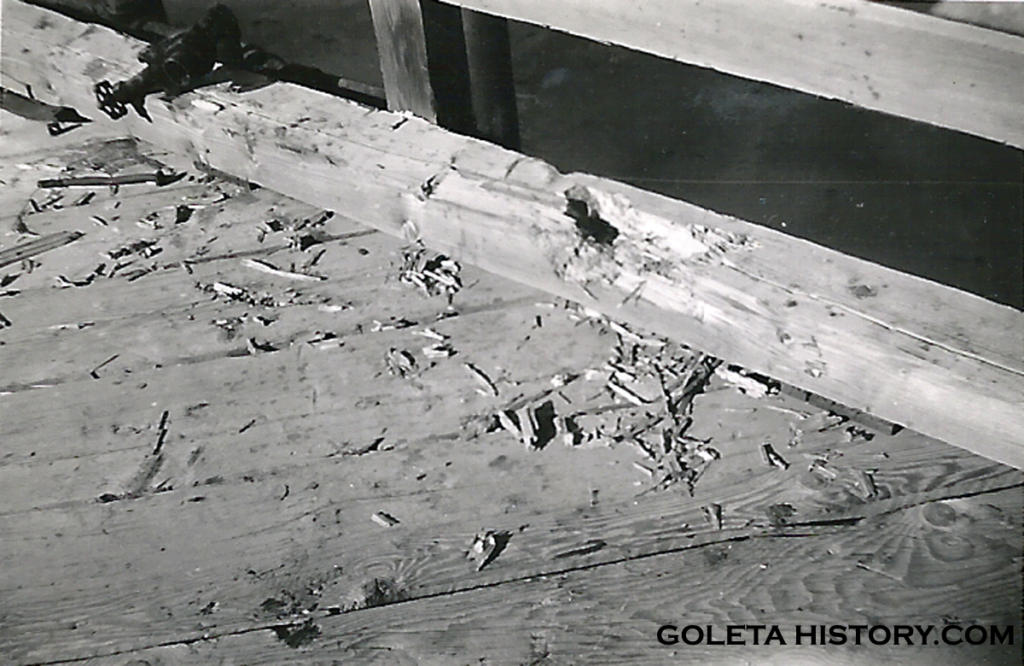
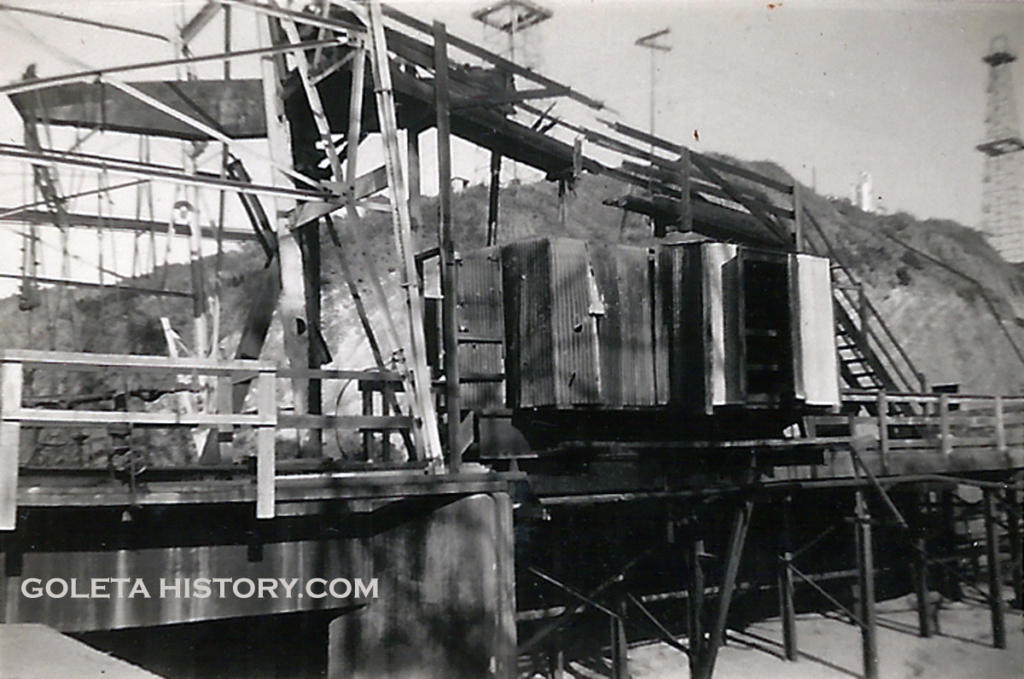
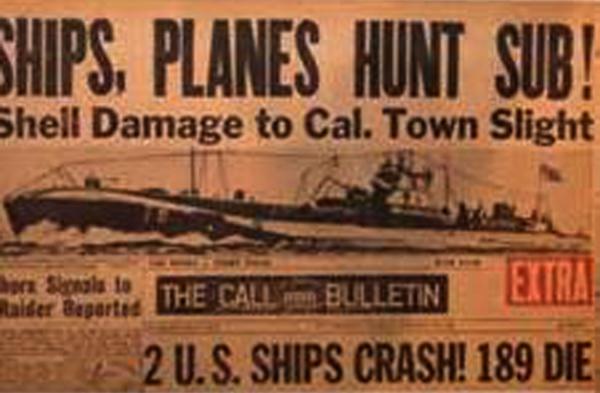

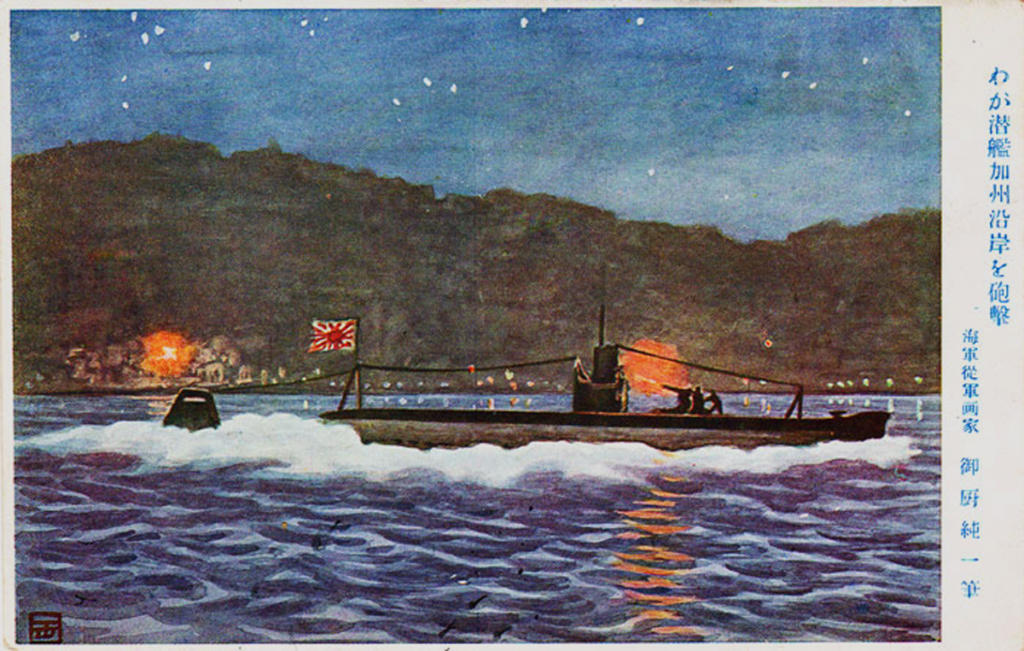
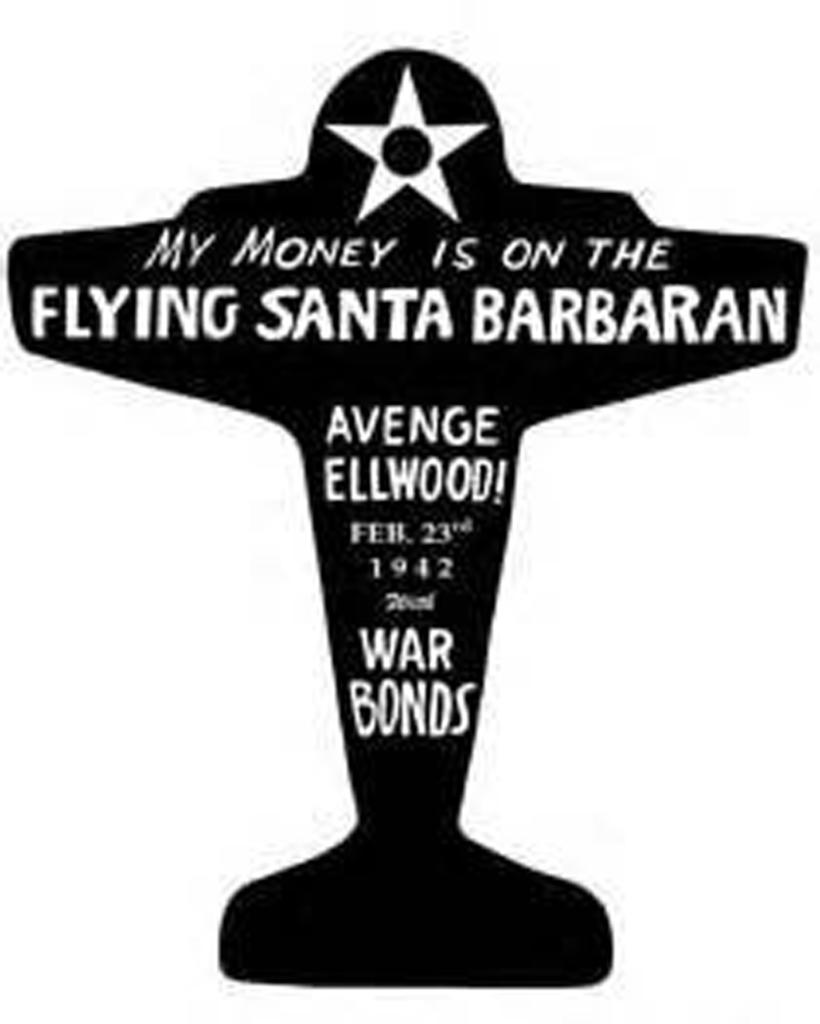

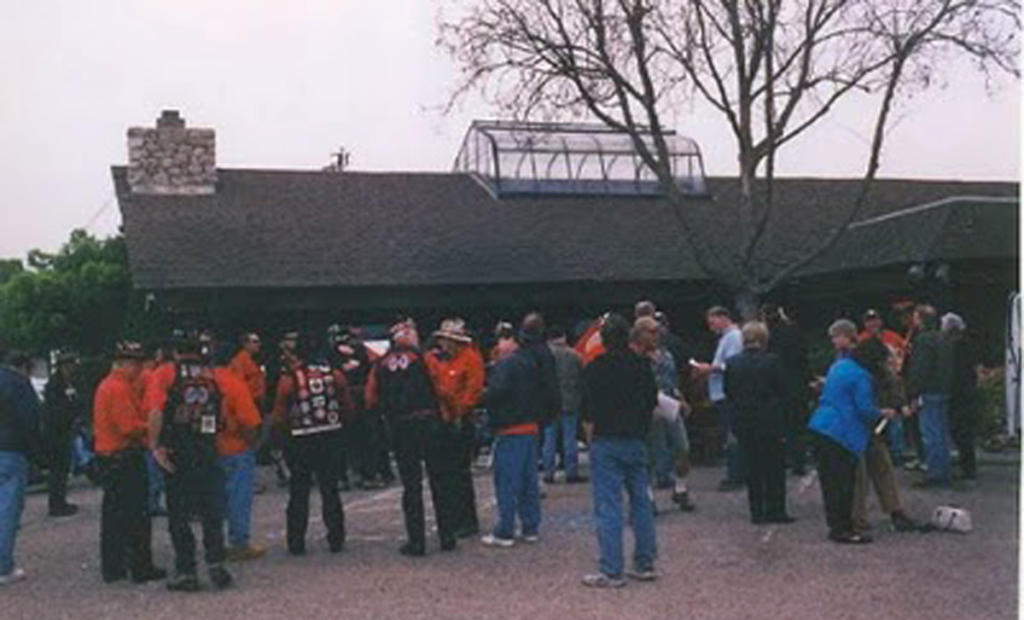
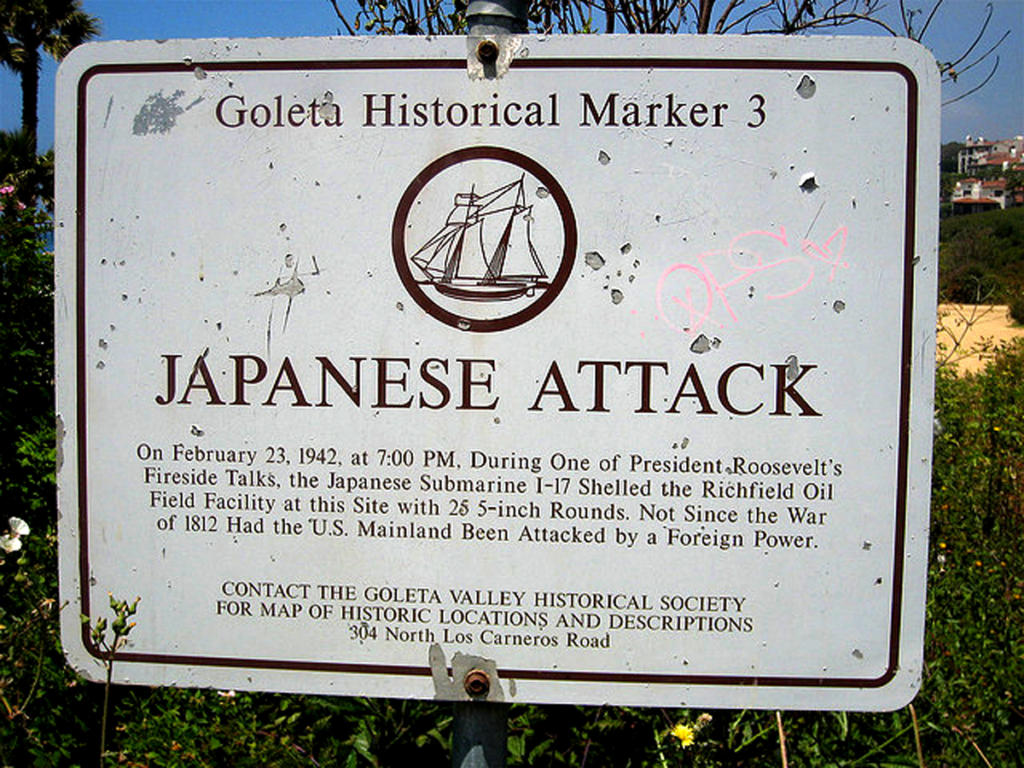
Thank you so much for this beautiful glimpse in Goleta history. I love our town and we have been residents here since 1995. Our town is and has been very under appreciated in a economic and intellectual value which we in majority contribute to SB County. We are one of the top hi tech industrial small towns in the California; Science magazine shows that Goleta is in the top 5% and, when the size of the population is taken into account, one of the top 5 research/enterpreneurship cities in CA alongside such places as Menlo Park (Xerox) and Palo Alto (Stanford-Silicon Valley).
Way to go GOLETA!
Awesome history. Love being a Goleta native.
Excellent account of the attack. It certainly clarifys and adds to what I had heard about the attack as a kid. “Ellwood was attacked by mini subs”! Not true! This sub was very large. Sadly, this attack led to the enlargement of the airport which meant that the natural Goleta Sough was filled in by removing earth from the historic plateau that the Chumash had once inhabited and cultivated.
I have a BUNKER on my property on meigs rd. water or army or ??? Does anyone know the history ????
Santa Barbara historian Neal Graffy thinks there was ammunition storage in that area during WWII. I gave him your email.
June 4, 2016
Sometime around 1960-1965 while living on the Mesa in Santa Barbara, my brother & I were digging around the base of an old dead tree in our greenhouse & found an old bomb. Police were called & all I can remember is that it was a supposed Japanese bomb fired in 1942 & said bomb was disposed off the end of Fisherman’s Wharf. Was this incident published anywhere? I’ve been curious all of these years. Thanks!
Great story! I’ve never heard of this incident. But I am quite sure the Japanese never shelled the Mesa. The U.S. military did have some arms bunkers on the Mesa however, and that would be my guess as to where the shell came from.
My grandfather was superintendent of the Signal Oil and Gas Company pumping and gas compression plant a little north of Goleta on the 101. He worked there from about 1935 until retirement in 1966. He was superintendent in late ’50’s up until retirement. They lived on the property. The houses and I believe all the associated buildings were razed, but the pier is still there and still in use. Now used as a dock for boats running workers out to offshore rigs. The pier used to be twice as long and had oil wells and pumping equipment on the end of the pier. I was 8 when he retired but have very fond memories of Goleta. I stayed with my grandparents a lot. Went to kindergarten at Ellwood Elementary school. I have many stories about that place. Fished off of that private pier until the late ’70’s. My family spent our 1965 family vacation on a bunkhouse that was once on the pier. It was August 1965, I had just turned 7. We walked to the end of the pier and saw an orange glow in the southern sky that was Los Angeles on fire during the Watts riots. We lived in L.A. and were glad we weren’t there at the time! My dad and I also found that tip of a missile or something while beach combing that same summer. Probably from the nearby air force base. Great memories.
Mark, great stories, thanks for sharing. I’d love to hear more! Also, this page may spark more memories https://goletahistory.com/haskells-beach/
“…about 60 miles north of Los Angeles…”
Come on, History Channel, you can do better than that. Sixty miles?!
On the morning of Feb 24, 1943, my father woke me from a sound sleep and said “get out of bed , quick” He said “we are going some place to see history being made”. I remember this as if it were yesterday. We traveled north from Ventura, where we lived, to Elwood. I remember sitting in the car as a fire truck was putting water on an object. My father told me what happened and gave me a lecture on what war was all about. I was born in 1938
Wow, that must have made quite an impression on you. Thanks for sharing that.
In 1985 I was 15 and lived right by there. The pictures here reminded me that I found a crater in a field by the beach (Santa Barbara Shores County Park). I always thought that was odd. I wonder whether that was from the shelling?
It’s possible!
Was the movie “1941” bases on this event?
Tom
When are you gonna start wearing a red shirt?
Your a Clamper if I ever saw one!
Thanks for the great work on some great history!
thanks James!
hi 78 the anniversary of the Ellwood attack Feb 23 2942 Feb23, 2021Thanks,! Col. Edson Andre’Johnson
Was there ever an attack by the Japanese that hit a train in the area…or maybe further north?
Not in Santa Barbara County
Tom, this is another of your fascinating reports on Goleta history. Thanks for debunking some of the myths surrounding the attack. I recently saw a presentation on this very subject by Neal Graffy. He noted that the I-17, like other Japanese subs of this class, actually had a sea plane stored on deck!
By the way, thanks for the outstanding report on the Goleta Slough. Great research.
I am a docent at the Santa Barbara Maritime Museum and welcome any new research that I can blend into the presentations I give to museum visitors. Thank you.
Thank you Steve.
Where there any recovered munitions from the attack?
There were quite a few shells found throughout the years.
I just listened to a japanese submarine audio book account of this incident. I did not know of it other than to watch that comedy movie 1941 with John Candy.
youtube channel WW 2 Tales (Japan was worried about Lexington Yorktown Saratoga and Enterprise)